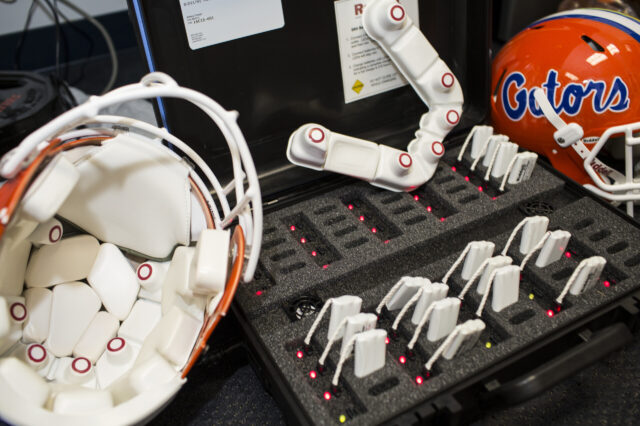Small changes to football practices can yield large reduction in head impacts, UF Health researchers find

Shortening the time spent on the highest-risk football drills could reduce the equivalent of nearly a year’s worth of head impacts over the course of a typical player’s career, University of Florida Health researchers have found.
Using helmet-mounted sensors, the researchers recorded more than 32,000 impacts during Gator football practices and scrimmages in 2016 and 2017. Researchers estimated that shortening time spent on the higher-risk drills by a total of 15 minutes could help players — especially linemen — avoid about 1,000 head impacts during their four-year college careers. The majority of these avoided impacts, about 80 percent, were concentrated within three drills identified as having among the highest impact rates, said James R. Clugston, M.D., a UF associate professor of medicine and a UF Athletic Association team physician. The findings were published recently in the Annals of Biomedical Engineering journal.
The research team, which also included UF Health neurology, neuropsychology and physiology experts, wanted to know if certain football drills had higher rates of head impacts.
“We thought we could design a better, safer football practice with minor adjustments instead of major changes such as converting an entire full-contact practice to a non-contact practice,” Clugston said.
To establish their findings, players’ helmets were fitted with six spring-mounted accelerometers to measure head impacts. Research assistants helped to log all of the players’ specific drills during the 2016 and 2017 training camps and practices.
Linemen had the highest impact rates during the study, which included spring, August training camp and regular season practices. The researchers concluded that minor adjustments to the time spent on drills with high impact rates or live scrimmages would reduce the number of head impacts by almost 1,000 for linemen and 300 for other positions during their college careers.
Clugston concedes shorter practices aren’t very likely to happen in a highly competitive college football environment. However, once a coach knows which drills were the highest risk, substituting time spent on those with lower-risk drills could reduce the exposure. The study found three drills to be especially high-risk: “team run,” a scripted running play from scrimmage; “move the field,” a scenario that spots the ball at different points on the field; and “team,” a series of full-contact, scripted offensive plays.
Reducing the time spent on those three drills by as few as three or four minutes per practice could significantly reduce head impacts, the researchers concluded. Overall, a different practice routine involving those three drills could reduce the equivalent of nearly a year’s worth of head impacts over the course of a typical player’s career, Clugston said.
“Realistically, most coaches are going to keep practices at the same length of time,” he said. “This gives them the guidance to hopefully pick less-dangerous drills or at least spread out the highest-risk drills to decrease ‘impact density,’ which has recently been described as important in concussion risk.”
While there are differences in the way college teams conduct practices compared with high school and youth football teams, Clugston said the findings also have potential use for younger athletes.
“It does show that you can look at the drills a team performs and figure out which ones are high-risk. It’s a way of looking at which drills are the worst for head impacts and then designing practices that decrease time spent in these drills,” he said.
About the researchers: James R. Clugston, M.D., is an associate professor in the UF College of Medicine’s department of community health and family medicine and director of the Sports Concussion Center at the UF Student Health Care Center. He also holds a joint appointment as a clinical associate professor in the College of Medicine’s department of neurology.
Breton M. Asken is a doctoral student in the neuropsychology track of UF’s clinical and health psychology department in the UF College of Public Health and Health Professions. He has also been a certified athletic trainer since 2013. He is currently completing his clinical neuropsychology internship through the Warren Alpert Medical School of Brown University.
About the author
